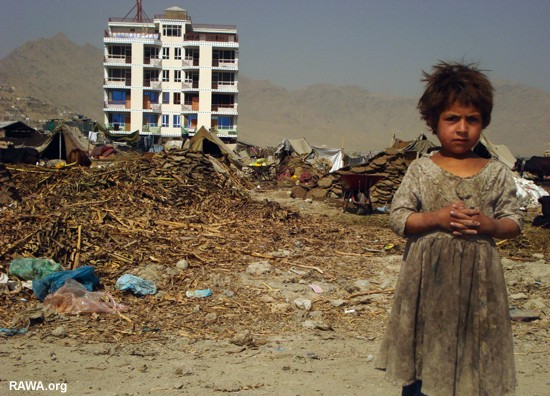FAIZABAD, Afghanistan - A woman haemorrhages to death as she lies screaming in agony in a spartan hut in a remote region of Afghanistan. There is no doctor or midwife to help and the hospital is several days journey away.
Women die this way every day in Afghanistan, a country with one of the world's highest maternal mortality rates.

Up to 18 million people in Afghanistan live on less than US$2 a day and are considered food-insecure, FAO says
About 1,600 Afghan women die in childbirth out of every 100,000 live births. In some of the most remote areas, the death rate is as high as 6,500. In comparison, the average rate in developing countries is 450 and in developed countries it is 9.
Virtually everyone in Afghanistan can recount a story about a relative dying in childbirth, often from minor complications that can be easily treated with proper medical care.
Sharifa's sister, a mother of six, bled to death after giving birth at home.
"There is no clinic, no cars, no proper roads. It is a remote village, we could not take her to hospital. She remained at home for one day and one night, then she died," recalled Sharifa, who identified herself only by her first name.
Afghanistan's government aims to reduce maternal mortality by 20 percent by 2020 but there are many obstacles to overcome such as a reluctance by women to be examined by male doctors and a lack of female doctors, nurses and midwives.
Then there are the vast distances in this war-torn country where hospitals are generally poorly equipped and medical help is inaccessible to those living in remote locations.
HOME BIRTHS
It is an age old practice for Afghan women in rural areas to deliver babies at home. Trained midwives are rarely in attendance. If there are complications, it might take hours, even days to reach the nearest clinic.
Even when women with labour complications get to hospital alive, there are often no doctors or medical equipment to perform caesarean sections and other life saving procedures.
"In some places, there aren't even operating theatres and women just wait for their death," said Rona Azamyan, who coordinates the Midwifery Education Programme in Faizabad.
Among the prime complications of childbirth in Afghanistan are bleeding, infection, hypertension and obstructed labour.
It is not uncommon for girls as young as 13 to marry in Afghanistan and there are often complications when they give birth.
"The mothers are very young, so their (pelvic) bone development is immature," said Karima Mayar, a family planning team leader at the Ministry of Public Health.
Poor and malnourished, many pregnant women in Afghanistan are severely anaemic.
"If they get post-partum haemorrhage, they will die 100 percent of the time," said Mayar.
Women's access to healthcare has generally been poor in deeply conservative Afghanistan.
Afghan men prefer their women to consult only women doctors, but that is easier said than done in a society where there are few female doctors and nurses and little emphasis is placed on educating girls.
The problem got worse during the Taliban regime, when girls were banned from schools and there were severe restrictions placed on women leaving their homes.
During those years, from 1996 to 2001, there were only around 1,000 female healthcare workers in the whole country, staffing female-only hospitals.
But the situation is still far from ideal now, more than six years after the fall of the Taliban, even in places such as the northeastern province of Badakhshan where the town of Faizabad is located. The area is far from fighting with Taliban insurgents.
Only 66 percent of basic healthcare centres have at least one female health worker. Women make up only 23.5 percent of the country's healthcare workforce and 27 percent of its nursing staff.
MATERNAL DEATH
"One woman dies every 27 minutes in Afghanistan due to complications in childbirth � and the tragedy doesn't stop with the mother's death," said Mayar.
"When the mother of a newborn dies, 75 percent of these babies die. Who will feed them, keep them warm? There's an Afghan saying: 'When the mother dies, the child is sure to die'."
The government plans to distribute the drug misoprostol to pregnant women in 13 provinces this year.
"We will distribute this to women in their seventh month of pregnancy and they must take it right after delivery. It will remove the placenta and prevent haemorrhage," Mayar said.
In the pipeline are plans to set up more midwifery schools and assign more female students to medical and nursing schools.
"To reduce maternal mortality, we need 8,000 midwives by 2010 to cover needs of all pregnant women," said Mayar. There are 2,143 midwives in the country of 26 million people.
But years of neglecting girls' education is taking its toll.
"In the provinces, the maximum level of education is the 10th grade, but the minimum requirement for entry into nursing school is 12th grade," said Fatima Mohbat Ali of the Aga Khan Foundation, an aid group in Afghanistan.
Some progress has been made in recent years, owing to government and NGO efforts to improve rural healthcare.
In Badakhshan's Eshkashem district, which borders Tajikistan, Afghan women have been frequenting the health clinic, the most modern looking facility in a town where most of the 13,000 residents live in mud houses.
From headaches to prenatal checkups, childbirth and advice on contraception, women have been bringing their complaints to the clinic's female doctor for the last three years.
"Ever since we got an ambulance, a lady doctor, two midwives and an operating theatre three years ago, we have not had a single case of maternal mortality," said Abdi Mohammad, head of the Eshkashem health clinic and an obstetric surgeon.



